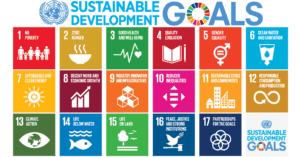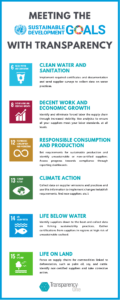The United Nations’ Sustainable Development Goals, commonly known as the SDGs, are a set of 17 goals adopted by UN members states in 2015 to help create a safer, more sustainable, and prosperous planet. The SDGs, which compass 169 individual targets, form part of the UN’s 2030 Agenda for Sustainable Development and are meant to “stimulate action over the next fifteen years in areas of critical importance for humanity and the planet.”
Companies around the world have recognized the importance of the SDGs and the role that business plays in helping achieve them. In fact, many have incorporated the Goals into their CSR strategies as a framework for their own corporate sustainability and social responsibility goals.

Achieving these large-scale goals requires large-scale change, but this transformation cannot happen overnight. For businesses, gaining greater supply chain transparency is an important first step in meeting their CSR goals as well as a variety of SDGs, including more responsible water usage (SDG 6), reduced greenhouse gas emissions (SDG 13), and elimination of forced labor (SDG 8).
Transparency empowers businesses to gather the necessary information about their supply chains to implement changes and meet their sustainability goals. As a result, businesses can also make progress towards achieving the UN SDGs by the 2030 deadline.
Here are 3 ways that supply chain transparency can help us meet the UN Sustainable Development Goals.
1. End-to-end visibility for complete supply chain knowledge
The SDGs are an ambitious set of goals and require ambitious action. For businesses to make adequate progress towards reaching these targets, they must address their entire supply chains, from source to store, in all corners of the world. For example, progress towards SDG 12 for “Responsible Production and Consumption” can only be made if businesses have visibility into production conditions at all facilities involved in the making of a product. Otherwise, they may miss crucial points along the supply chain and only make partial progress towards their goal.
End-to-end visibility also means businesses can get the information they are looking for directly from the appropriate stakeholder, rather than relying on a single point of information. Transparency connects companies at the source (farm, ocean, mine, etc.) with those at the consumer level. Direct access means speedier responses and lower chance of erroneous or missing information.
2. Communication with supply chain stakeholders
Transparency establishes a line of communication with all stakeholders in a supply chain. This open line of communication means businesses can more effectively implement requirements and ensure they are being met. Requirements set for certificates, documentation, or information on business practices are sent to a specific point of contact at a specific facility, rather than into a void.
Increased communication also means that requests can be sent within context. Sharing why certain requirements are being sent (such as a corporate objective to meet the SDGs) in addition to the requirements themselves increases the likelihood of participation.
Finally, communication allows businesses to work with their suppliers and meet them where they currently are. For example, if a certain supplier is struggling to meet a requirement, client and supplier can discuss together to identify areas of difficulty and address possible intermediate steps.
 3. Proactive risk management
3. Proactive risk management
Proactive risk management helps a business focus on what matters most, such as issues addressed by the SDGs. In case of a crisis, transparency reduces the amount of time necessary to determine who should be contacted, where the affected materials are coming from, or what products are impacted.
The time saved can then be dedicated towards more proactive risk management for issues relevant to the SDGs. For example, companies can determine areas at potential risk of deforestation (SDG 15) or forced labor (SDG 8) and determine if or how their supply chains may be impacted.
***
The objective of the Sustainable Development Goals is to achieve a way of doing business, across all industries, that paves the way for a more sustainable world. Transparency plays a key part in creating this sustainable world by arming businesses with knowledge about their supply chains, and the means to collaborate. Transparency empowers businesses to take the steps needed to achieve the SDGs.









